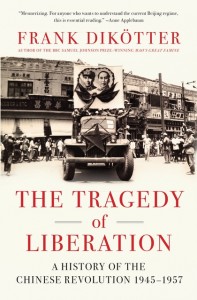Review of lecture, Frank Dikötter: The Tragedy of Liberation
 Yesterday evening one could hear pins drop. Speaking in front of a packed house in Amsterdam was Professor Frank Dikötter. His latest book “The Tragedy of Liberation, a History of the Chinese Revolution 1945-57“ depicts the atrocities deliberately inflicted on the Chinese people by the Chinese Communist Party well before 1949 and following the fleeing of the Nationalists to Taiwan. In calm and vivid strokes he tells about the waves of terror unleashed on the Chinese public by Mao Zedong eventually resulting in 50 million deaths by 1962.
Yesterday evening one could hear pins drop. Speaking in front of a packed house in Amsterdam was Professor Frank Dikötter. His latest book “The Tragedy of Liberation, a History of the Chinese Revolution 1945-57“ depicts the atrocities deliberately inflicted on the Chinese people by the Chinese Communist Party well before 1949 and following the fleeing of the Nationalists to Taiwan. In calm and vivid strokes he tells about the waves of terror unleashed on the Chinese public by Mao Zedong eventually resulting in 50 million deaths by 1962.
Dikötter’s lecture took the audience to places in China, small villages and towns in the countryside and cities like Shanghai that had seen systematic and organised terror in the forms of deliberate starvation, torture, persecution and relentless intimidation. For starters, he described the discovery of a mass grave in Jilin Province, initially thought to have consisted of Japanese bodies. But further research uncovered that the Red Army had besieged the Manchurian city of Changchun in 1948 under command of Field Marshall Lin Biao, ‘ordering it into a city of death’. In a period lasting five months, ordinary inhabitants were deliberately starved to death – claiming 160,000 victims.
During the Civil War (1945-49) and after Liberation came the introduction of Land Reform throughout the countryside. He tells of one landlord who stood out of the crowd because he had a glass windowpane in his mud house and had been elected village chief earlier- enough to brandish him a class enemy. Most people who have studied China know that this period consisted of ruthless and mindless denunciations and killings of landlords. But in Dikötter’s story we hear about how cleverly the Communists engineered the peasants’ involvement in these infamous struggle sessions. Either they unwittingly became part of the murder machine or simply had no choice: eventually, everyone had blood on their hands.
Thanks to Dikötter’s meticulous research in previously classified Chinese party archives (but also from many different other sources, including diaries and personal witness accounts) throughout the country, he has dug up ample evidence of Mao Zedong’s terror tactics, one of which was the introduction of a killing quota of one civilian per 1,000. He mentions that an overzealous Deng Xiaoping even ordered three per 1,000. These quota killings of course served an effective purpose because they were instrumental in weeding out potential ‘enemies of the state’ and as a fear tactic, it did a great job in breaking any form of resistance.
In simple and lucid language Dikötter paints a grim picture of Mao who had laboriously studied the rise of Joseph Stalin and the Soviet Gulag apparatus, improved the latter’s terror tactics and understood cleverly how to pit one group of people against the other. For anyone, including yours truly, believing that the early years following 1949 Liberation consisted of widely carried feelings of belief in and hope for a better life and a peaceful future, Dikötter’s talk certainly puts some heavy cracks in those assumptions. As 1951 saw the launch of the Great Terror, officials throughout the country implemented this policy with fervour, often trying to outdo one another, even resorting to burying people alive.
He explains how violence was supported by cleverly timed, smooth promises by Mao to curry favour with different groups at particular times, and how everyone fell for these promises. Intellectuals, entrepreneurs, workers, peasants and officials – everyone at one time or another believed they would fall under the protective wings of the Party, only to be cast aside or worse, denounced or killed. The thriving and bustling city of Shanghai was bled dry: shopkeepers had to hand over their possessions to the state for redistribution. No one was spared.
Again these facts are not unknown, but the way in which Dikötter supports these accounts with painstaking research he and his team carried out over the last decades is unnerving and shows the extent of planning top down that went into the numerous murderous campaigns.
Shocking are the stories of persecuted children. Dikötter mentions a few explicit examples of children, their names well documented, who were rounded up as either spies or traitors and tortured or killed. Even if one tries to phantom turbulent times in which heinous crimes are committed, here we are talking about a time in which peace supposedly prevailed, at least to the outside world. Youngsters as young as six fell under the blind and uncritical scrutiny of political brigades filled with ambition to ‘do good’ in the name of the Party. No wonder China suffers from collective amnesia, as Dikötter puts it. The crimes perpetrated by the Party fill a long list. While political campaigns swiped and ravaged the country, each time targeting different categories of people, society’s social fabric blistered away. No memorials, no remembrance days, let alone soul searching by the Party itself, nothing to help heal any of the deeply rooted wounds caused at the hands of the party leadership.
In drawing analogies with China’s current leadership, Dikötter compares the movements and mantras of Party Chief and President Xi Jinping to those of Mao Zedong. Publicly hanging top cadres and minor officials out to dry by expelling them from the Party on charges of corruption is nothing new. Here Xi has clearly embraced Mao Zedong’s slogan of ridding the Party of “tigers” and “flies” (senior party bureaucrats and lowly officials) in a typical referral to his rectification campaign in the early 50’s to oust the party of corruption, in which, incidentally, Xi’s father Xi Zhongxun alone identified 340,000 corrupt cases in the north of China- but particularly including people who opposed certain policies, intellectuals and others who could potentially pose a threat to the Party. Visiting farmers and peasants to curry favour is nothing new and coming down hard on people who are even a little critical is standard procedure (yesterday a new law came into practice that can put netizens into jail for up to three years if they are caught spreading false rumours that can harm China, or lead to suicides!) – it has all been done before. Even though China is now a vastly different world, the Party will continue to do everything within its power to keep control, regardless of the cost. It has too much to lose says Dikötter.
Personally, I get his message, and Dikötter doesn’t make any predictions but I have been quietly hopeful – perhaps naively so, that the current leadership realises they must curb widespread corruption in order to prick up their tarnished image. Indeed, protecting their majestic positions and those of their families, friends, protégées and erstwhile colleagues is key to their existence. But say this is ‘accepted’, is Xi Jinping c.s. not in charge of a whale of a ship surrounded by so many counterproductive organisms that his gargantuan task of getting China on the straight and narrow is almost an impossible one? Is there not a clear sense of urgency to maneuver the Party into a shape that can help regain some of its lost legitimacy? If he were truly and well on top of it all, would he consider slackening the reigns a little? Is he perhaps not still in the middle of consolidating his power. And therefore, is it not too early to say anything about the direction this current leadership is taking?
If anything, reading Dikötter’s book will undoubtedly reveal the amount of scar tissue on the Chinese soul stacked up over decades following not only the most miserably failed and devastating political campaigns and policies, but also caused by daily existential fear at work, in school and at home. It surely is a must-read for those who are in the business of peeling away layer upon layer of China insides in order to understand the country and its people better. But more importantly probably to the author is that by revealing and exposing what happened, all those forgotten millions are given a voice. It is revealing that Dikötter’s book in China is labelled as a ‘fabrication’. Something, he says, he finds a great compliment.
Review written by Lilian Kranenburg, ChinaMoves
11 September 2013
Frank Dikötter, The Tragedy of Liberation, a history of the revolution 1945-57, London, Bloomsbury Publishing, 2013



4 Responses to “Review of lecture, Frank Dikötter: The Tragedy of Liberation”